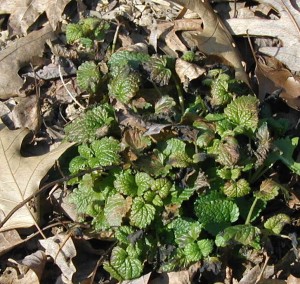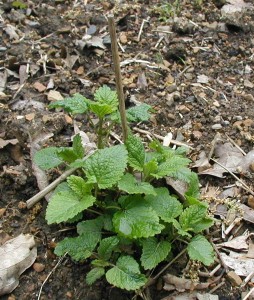When I planted lemon balm last year, I was hoping to find a herb that could accent chicken or vegetables with a lemony flavor. I don’t know for sure, but the Pledge(TM)-like scent of lemon balm seems too strong for my taste.
Lemon balm was planted last year from seed and a couple of small plants survived winter here in Central Pennsylvania. They got a bit of a late start, so instead of using this herb last year we let the plants grow to establish themselves.
Lemon balm seems to be a hardy plant as evidenced by its surviving the freezing conditions. Witness the dark edges in the photo below.
(Click on any photo to see a larger image.)

Plants left open in the garden with no protection from winter weather overwintered just fine. The leaves are developing to a bright green color. I was very glad to have placed a long skewer into the soil next to each herb plant that was left in the garden. That way, in my early spring cleaning and weeding I wouldn’t (and didn’t!) blindly take out a potentially useful herb. It’s a good idea to mark perennial plants, like lemon balm, with stakes or some other kind of marker.

The plants continue to grow strong now. Perhaps they’ll be good for companion planting. Does lemon balm provide any bug-away benefits? Maybe it would make a nice plant pesticide or plant companion. So, that’s it for now — the lemon balm gets to stay in the garden to act as a repellant for insects until we learn more about lemon balm and all its uses.
The citronella-like smell is what turns me off for using this herb in food, but the odor and taste probably change upon heating or blending with other herbs, so it’s worth trying out. Does anybody out there care to mention how you use lemon balm?